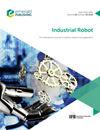A point cloud registration-based calibration algorithm for robot offline programming automatic loading in aero-grinding applications
IF 2.5
4区 计算机科学
Q3 ENGINEERING, INDUSTRIAL
Industrial Robot-The International Journal of Robotics Research and Application
Pub Date : 2022-05-19
DOI:10.1108/ir-12-2021-0284
引用次数: 7
Abstract
Purpose During the process of the robotic grinding and polishing operations on aero-engine blades, the key problem of calibration error lies in fixture error and uneven margin. To solve this problem, this paper aims to propose a novel method to achieve rapid online calibration of the workpiece coordinate system through laser-based measurement techniques. Design/methodology/approach The authors propose a calibration strategy based on point cloud registration algorithm. The main principle is presented as follows: aero blade mounted on clamping end-effector is hold by industry robot, the whole device is then scanned by a 3D laser scanner to obtain its surface point cloud, and a fast segmentation method is used to acquire the point cloud of the workpiece. Combining Super4PCS algorithm with trimmed iterative closest point, we can align the key points of the scanned point cloud and the sampled points of the blade model, thus obtaining the translation and rotation matrix for calculating the workpiece coordinate and machining allowance. The proposed calibration strategy is experimentally validated, and the positioning error, as well as the margin distribution, is finally analyzed. Findings The experimental results show that the algorithm can well accomplish the task of cross-source, partial data and similar local features of blade point cloud registration with high precision. The total time spent on point cloud alignment of 100,000 order of magnitude blade is about 4.2 s, and meanwhile, the average point cloud alignment error is reduced to below 0.05 mm. Originality/value An improved point cloud registration method is proposed and introduced into the calibration process of a robotic system. The online calibration technique improves the accuracy and efficiency of the calibration process and enhances the automation of the robotic grinding and polishing system.基于点云配准的航空磨削机器人离线编程自动加载标定算法
目的在航空发动机叶片机器人磨削抛光过程中,标定误差的关键问题是夹具误差和余量不均匀。为了解决这一问题,本文提出了一种利用激光测量技术实现工件坐标系快速在线标定的新方法。作者提出了一种基于点云配准算法的标定策略。其主要原理是:工业机器人握住装在装夹末端执行器上的气动叶片,用三维激光扫描仪对整个装置进行扫描,获取其表面点云,并采用快速分割方法获取工件的点云。将Super4PCS算法与裁剪迭代最近点相结合,将扫描点云的关键点与叶片模型的采样点对齐,从而得到用于计算工件坐标和加工余量的平移和旋转矩阵。实验验证了所提出的标定策略,最后分析了定位误差和余量分布。实验结果表明,该算法能较好地完成叶片点云的跨源、部分数据和相似局部特征配准任务,精度较高。10万数量级叶片的点云对准总时间约为4.2 s,同时平均点云对准误差减小到0.05 mm以下。提出了一种改进的点云配准方法,并将其引入机器人系统的标定过程中。在线标定技术提高了标定过程的精度和效率,提高了机器人磨削抛光系统的自动化程度。
本文章由计算机程序翻译,如有差异,请以英文原文为准。
求助全文
约1分钟内获得全文
求助全文
来源期刊
CiteScore
4.50
自引率
16.70%
发文量
86
审稿时长
5.7 months
期刊介绍:
Industrial Robot publishes peer reviewed research articles, technology reviews and specially commissioned case studies. Each issue includes high quality content covering all aspects of robotic technology, and reflecting the most interesting and strategically important research and development activities from around the world.
The journal’s policy of not publishing work that has only been tested in simulation means that only the very best and most practical research articles are included. This ensures that the material that is published has real relevance and value for commercial manufacturing and research organizations. Industrial Robot''s coverage includes, but is not restricted to:
Automatic assembly
Flexible manufacturing
Programming optimisation
Simulation and offline programming
Service robots
Autonomous robots
Swarm intelligence
Humanoid robots
Prosthetics and exoskeletons
Machine intelligence
Military robots
Underwater and aerial robots
Cooperative robots
Flexible grippers and tactile sensing
Robot vision
Teleoperation
Mobile robots
Search and rescue robots
Robot welding
Collision avoidance
Robotic machining
Surgical robots
Call for Papers 2020
AI for Autonomous Unmanned Systems
Agricultural Robot
Brain-Computer Interfaces for Human-Robot Interaction
Cooperative Robots
Robots for Environmental Monitoring
Rehabilitation Robots
Wearable Robotics/Exoskeletons.

 求助内容:
求助内容: 应助结果提醒方式:
应助结果提醒方式:


